
USS Mackerel (SS-204), the lead ship of her class of submarines, was the first ship of the United States Navy named for the mackerel. Mackerel and her near-sister Marlin were prototype small submarines which the Navy was exploring to replace the aging S-class submarines.
The second USS Sapphire (PYc-2) was a patrol boat in the United States Navy.
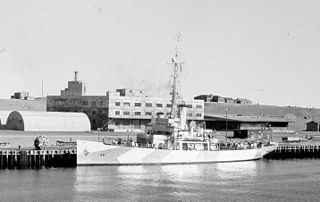
USCGC Modoc (WPG-46) was a 240-foot Tampa-class United States Coast Guard cutter designed for multi-mission roles. She had a top speed of sixteen knots, and was armed with a pair of 5-inch deck guns. With the breakout of war she was armed with depth charges, additional guns, sonar, and radar and transferred to the Navy. Modoc, along with her sister ships Mojave and Tampa joined the Greenland Patrol.

The USCGC Escanaba (WPG-77) was a 165 ft (50 m) "A" type United States Coast Guard cutter stationed on the Great Lakes from her commissioning in 1932 until the start of U.S. military involvement in World War II in 1941. With the outbreak of war, Escanaba redeployed to participate in the Battle of the Atlantic, during the course of which she was ultimately lost with nearly all hands. Struck by either a torpedo or mine in the early morning of 13 June 1943, while serving as a convoy escort, Escanaba suffered a fiery explosion and sank within minutes, leaving only two survivors and one body out of her 105-man crew to be found on the surface by rescuers.

USCGC Mellon (WHEC-717) was the third United States Coast Guard Hamilton-class high endurance cutter constructed. The 2,748-ton cutter’s ocean crossing range was 10,000 miles at 20 knots.

USS Biscayne (AVP-11), later AGC-18, was a United States Navy Barnegat-class seaplane tender in commission as a seaplane tender from 1941 to 1943 and as an amphibious force flagship from 1943 to 1946. She saw service during World War II. Transferred to the United States Coast Guard after the war, she was in commission as the Coast Guard cutter USCGC Dexter (WAGC-385), later WAVP-385 and WHEC-385, from 1946 to 1952 and from 1958 to 1968.

The USCGC Evergreen was a Cactus-class seagoing buoy tender operated by the United States Coast Guard. She served in the North Atlantic during World War II and participated in the International Ice Patrol in these waters after the war. She was the first dedicated oceanographic vessel in the Coast Guard's history. She was decommissioned in 1990 and sunk by the US Navy for target practice in 1992.

USCGC Cuyahoga (WIX-157) was an Active-class patrol boat built in 1927 which saw action in World War II. Cuyahoga sank after a night-time collision in the Chesapeake Bay while on patrol in 1978. She was later raised and re-sunk as an artificial reef off the Virginia coast and is a popular recreational dive site.

The Ukrainian patrol vessel Sloviansk (P190) was an Island-class patrol boat of the Naval Forces of the Armed Forces of Ukraine. Originally named USCGC Cushing when in service with the United States Coast Guard, the vessel was acquired by Ukraine in 2018 and arrived in Ukraine on 21 October 2019. Sloviansk was sunk in combat on 3 March 2022 by a Russian air-to-surface missile.
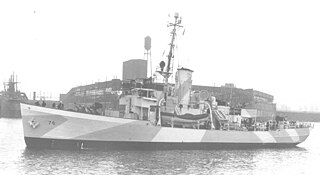
USCGC Comanche (WPG-76) was a United States Coast Guard cutter built by Pusey & Jones Corporation, Wilmington, Delaware, and launched 6 September 1934. She was commissioned on 1 December 1934. She was used extensively during World War II for convoy operations to Greenland and as a part of the Greenland Patrol.
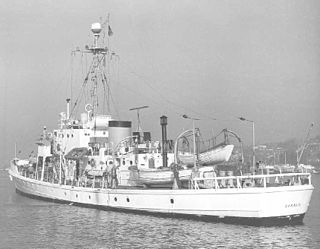
USCGC Cahoone (WPC/WSC/WMEC-131) was an Active-class patrol boat of the United States Coast Guard. Launched in 1927, she served until 1968.
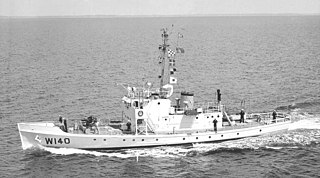
The Active-class patrol boat was one of the most useful and long-lasting classes of United States Coast Guard cutters. Of the 35 built in the 1920s, 16 were still in service during the 1960s. The last to be decommissioned from active service was the Morris in 1970; the last in actual service was the Cuyahoga, which sank after an accidental collision in 1978.

USCGC Crawford (WSC-134), was a 125 ft (38 m) United States Coast Guard Active-class patrol boat in commission from 1927 to 1947. She was named for William H. Crawford, (1772–1834) who was appointed in 1816 as Secretary of the Treasury by President James Madison and he continued under President James Monroe through 1825. Crawford was the seventh vessel commissioned by the U.S. Revenue Cutter Service and the Coast Guard named after the former secretary. She served during the Rum Patrol and World War II performing defense, law enforcement, ice patrol, and search and rescue missions.

USCGC Chelan was a Lake-class cutter belonging to the United States Coast Guard launched on 19 May 1928 and commissioned on 5 September 1928. After 13 years of service to the Coast Guard, she was transferred to the Royal Navy as part of the Lend-Lease Act, and named HMS Lulworth (Y60). During the war Lulworth served in a convoy Escort Group for Western Approaches Command

USCGC Joseph Tezanos (WPC-1118) is the United States Coast Guard's 18th Sentinel-class cutter. She was commissioned on August 26, 2016. She was the sixth of the first cohort of six FRCs home-ported in San Juan, Puerto Rico.

USCGC Reliance (WSC-150) was a 125-foot (38 m) steel-hulled single-screw Active-class patrol boat of the United States Coast Guard. She served from 1927 to 1948.

USCGC McLane (WSC-146) was a 125 ft (38 m) United States Coast Guard Active-class patrol boat in commission from 1927 to 1971. She was named for Louis McLane, (1786–1857) who was appointed in 1833 as United States Secretary of State. In May 1966, she was redesignated as (WMEC-146).
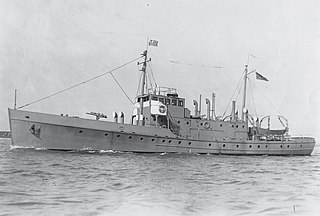
USCGC Jackson was an Active-class cutter of the United States Coast Guard. She capsized in 1944, killing twenty one of forty crew members.
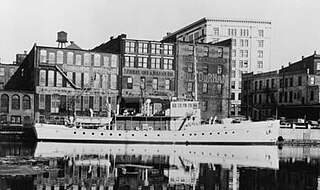
USCGC Antietam (WSC-128), later Bedloe was an Active-class cutter of the United States Coast Guard where she was commissioned from 1927 to 1944. She sank in 1944, killing 26 crewmembers.
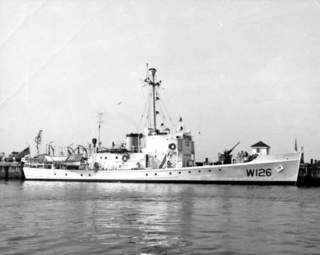
USCGC Agassiz (WSC-126) later WMEC-126, was a steel hulled, single screw Active-class patrol boat of the United States Coast Guard which served between 1927 and 1969.
















